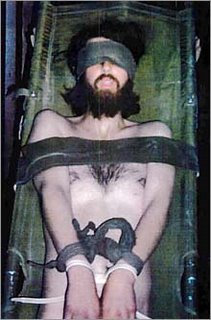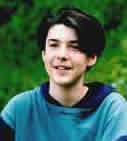| An exclusive look at Lindh's life behind bars
| ||||
|
| ||||
But there's really no other 25-year-old like John Walker Lindh. He will be forever tagged as the American Taliban, a California kid who converted to Islam and left home to find himself - and joined the radical Taliban to fight in Afghanistan. Now Lindh is serving a 20-year prison sentence, and is under a court-imposed silence. But Lindh's family and supporters say he deserves a break, and America needs to take another look at what he really did. |
 "His story is indeed a story that needs to come out, and needs to be shared with the world," said Shakeel Syed, who served as a religious adviser to Lindh in prison.
"His story is indeed a story that needs to come out, and needs to be shared with the world," said Shakeel Syed, who served as a religious adviser to Lindh in prison.
In his first-ever account of Lindh's life in a medium-security federal prison in Victorville, Calif., Syed said Lindh is a model inmate who lives as normal a life as possible behind bars - but also is a spiritual beacon to other Muslims there.
"Prison has helped him become a better Muslim," Syed said. "He is a Malcolm X with a softer tone."
Lindh lives with a cellmate, works a prison job and is allowed to mingle with other inmates, Syed said - but he is prohibited from talking about his experiences in Afghanistan, can't see visitors who aren't relatives or lawyers, and isn't allowed to speak Arabic.
Contained ... this above shot of John Walker Lindh shows him bound naked in a container at Camp Rhino, near Kandahar, following his capture in December, say his defence lawyers, who released the photograph
While Lindh was taunted with cries of "Traitor!" when he first came to Victorville, and was once attacked by another inmate, he now faces no threats to his safety and even has gained a measure of respect, Syed said.
"He is an extremely well-liked, well-respected, model inmate in the system by the authorities as well as by the inmates," said Syed, now executive director of the Islamic Shura Council of Southern California. "Some of the inmates have come to sympathize with him because of his special restrictions."
Federal prison officials would not comment on Lindh or release information about him, citing privacy rules.
He burst into the public eye in November 2001, when CIA commandos working with the Northern Alliance, an Afghan group opposed to Taliban rule, found him among wounded and bedraggled Taliban fighters, who soon killed CIA operative Johnny (Mike) Spann.
The image of Lindh, filthy and exhausted, was beamed around the world - shocking the country with his unbelievable journey and stunning his parents, who hadn't heard from him in months.
Lindh had converted to Islam as a teen and traveled to Yemen to study the Koran and Arabic. When his visa expired he went to Pakistan, then sneaked across the border to Afghanistan - where he trained in an Al Qaeda-funded camp and twice met Osama Bin Laden.
Lindh's father, Frank Lindh, said his son was well-meaning but misguided, never taking up arms against America or joining Al Qaeda in its destructive quest.
"In simple terms, this is the story of a decent and honorable young man who became involved in a spiritual quest and became the focus of the grief and anger of an entire nation over an event in which he had no part," Frank Lindh told a San Francisco audience earlier this year.
But in the angry months after Sept. 11, Lindh was held up as a candidate for the death penalty.
Barely 10 months after he was seized on the battlefield, Lindh accepted a plea deal admitting he aided the Taliban - not plotting terror attacks or battling the U.S. He agreed to a 20-year prison term with no opportunity to appeal or challenge the government's restrictions while he's in prison.
Lindh's last public statement came when he was sentenced, where he tried to explain how he ended up in Afghanistan.

"I did not go to fight against America, and I never did," Lindh said. "I understand why so many Americans were angry when I was first discovered in Afghanistan. I realize that many still are, but I hope that with time and understanding, those feelings will change."
His parents have said little since then, but his lawyers are hoping a change in public mood could help him. With few legal options available, they've petitioned President Bush in a long-shot bid to shorten Lindh's sentence.
"I think we all have to realize that the odds are against it," Frank Lindh said in his San Francisco speech. "It is difficult to envision a situation where all those hotheads in Washington can turn around and recognize the kid got a raw deal and should be released."
Legal observers said the sentence was the byproduct of the national mood at the time, and note that many subsequent terror prosecutions in the U.S. have led to much shorter prison terms.
"He became an almost cathartic criminal case for the public," said George Washington University law Prof. Jonathan Turley. "Just as the public emotion was at a fever pitch, John Walker Lindh walked right out of central casting as a vicious traitor who betrayed his country. Upon further examination, he appears to be a confused kid playing a low-level role."
Originally published on April 2, 2006
KEY Words: American Taliban, John Walker Lindh, Books about John Walker Lindh, Google images of John Walker Lindh
Investigating the transformation of John Walker Lindh from a typical American teenager into the most infamous turncoat of our day, Kukis, a former UPI White House correspondent, traces the influences that played a part in Lindh's metamorphosis, from his California childhood to his capture in Mazar-i-Sharif. While unable to interview the young man himself (due, according to the publisher, to Attorney General Ashcroft's gag order) or his parents, the author draws from conversations he had with those who knew Lindh and witnessed his experiences-friends, teachers, lawyers, fellow students, family members and Taliban soldiers-all the way from San Francisco to Afghanistan, Pakistan and Yemen. Despite all the hype surrounding Lindh, Kukis "vowed to keep an open mind" in the research and writing of his biography, and expresses his hope that "understanding Lindh...will help us, as Americans at war, to reflect on ourselves as well as the enemies we face." B&w photos, maps. Copyright 2003 Reed Business Information, Inc.
Mahoney claims that his new book puts not only John Walker Lindh on trial but the entire U.S. government, for what he calls its treasonous double dealings with states that aid terrorists. Part biography of Lindh, part courtroom transcript, part military field report and in large part conjecture, the book, while often muddled and disconnected, raises important questions about the precarious nature of the U.S.'s alliances with Saudi Arabia and Pakistan. The author claims, as have others, that the U.S. enabled the rise of the Taliban by arming the mujahideen fighting the Soviets in Afghanistan in the 1980s. Most readers will find, though, that the charge that this constitutes treason ignores the complexity of the geopolitical landscape. Mahoney's second claim is that, because of its insatiable thirst for oil and profit, the U.S. habitually turns a blind eye to Saudi Arabia's and Pakistan's support of terrorism. The author's main charge, however, is that the Justice Department abruptly stopped Lindh's trial for fear of what might be revealed. This charge ignores what the judge noted: the evidence of Lindh's conspiracy to kill Americans was far from compelling, though Mahoney weakly argues the opposite. While providing much fodder for conspiracy theorists, Mahoney (Sons and Brothers: The Days of Jack and Bobby Kennedy) falls short of making his sweeping indictments stick.
Copyright © Reed Business Information, a division of Reed Elsevier Inc. All rights reserved.




No comments:
Post a Comment